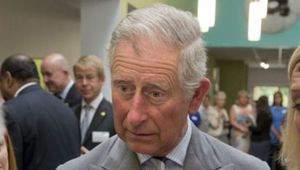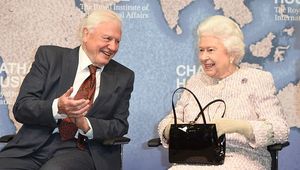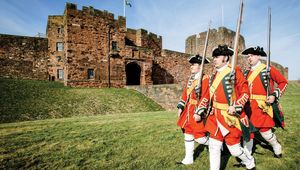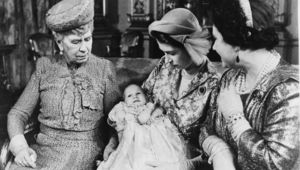
Letters and Miscellany
STIFF UPPER LIP
“Vigilance but not panic” is the phrase one British official used to describe the scene in London during the immediate aftermath of the terrorist attacks of July 7. Indeed. It hardly needs to be said that the civilized world stands united in its condemnation of this ugly festering of the international terror of our times. The city and people of London deserve nothing but accolades for the way in which they reacted to the coordinated bombings and the attendant horrors of that morning.
[caption id="AroundOurScepteredIsle_img1" align="aligncenter" width="678"]

AFP/Getty Images
Security officials in England acknowledged that such an attack upon London was inevitable: “a matter of when but not if.” Correspondents on both sides of the Atlantic were quick to affirm that London was the best-prepared city in the world for dealing with a terrorist attack. Emergency services responded magnificently to the difficult challenge presented at multiple locations. As Christiane Amanpour of CNN commented, “The Brits aren’t a panicky people.”
American diplomat and former senator George Mitchell was in London at the time. His comment provides a salient summation of Britain’s immediate response to this attack on its capital and its citizens: “The British are a tough and resilient people. They cannot be bullied.”
The cowardly bombings of this summer were the worst attack on human life that London has experienced since the dark days of World War II. Now, two generations later, Londoners have again demonstrated their tenacity and resolve as a people not to allow this latest manifestation of international criminality to shake either their spirit or their way of life. Good show, London!
DO YE KEN JOHN BULL?
It was Dr. John Arbuthnot, wit and satirist, and close friend of Jonathan Swift and Alexander Pope, who created the character of John Bull in 1712. Popularized first by English printmakers and later by illustrators like Thomas Nash, John Bull is a national anthropomorphism of Britain, not unlike our own Uncle Sam. Bull is a stocky, conservative and well-meaning fellow, usually depicted in breeches and a tailcoat, with a Union Jack waistcoat.
I knew him, Horatio. A fellow of infinite jest. For me, John Bull will always be personified by a feisty Cheshireman named Arthur Smith, who passed away recently in his mid-90s. Smith was 12 when he left school in Stockport to help support the family following his father’s death from wounds received in World War I. During his own war, Smith was a scrounger, helping mobilize and equip units from Barry Island to Hampshire in preparation for the invasion of Europe. On D-Day, he was in the vanguard on Sword Beach, and in the months that followed, he went through Europe as the quartermaster sergeant at Montgomery’s headquarters.
After the war, Smith took a job sweeping up the floor of a factory in Poynton. In due course, he rose to become director of development for the parent company—in charge of factories in 17 countries—and to hold a handful of patents in manufacturing engineering. After his early retirement to Buxton, he opened a frozen food center, a printing company and a chain of launderettes.
I met Arthur Smith and his dear wife, Lilian, a quarter-century ago, some time after his second retirement in posh Ascot, next door to Royal Windsor. Beside him I traveled the island from Kent to Caernarfon; from him I learned the intricacies of cricket and the qualities of real ale; with him I shared practical jokes, political philosophy and the joy of English life. In his late 70s, Smith took up golf and played actively for a dozen years. In his 80s, he discovered opera and became a fan. At 90, he could party deep into the evening and dance with Lilian to “There’ll Be Bluebirds Over the White Cliffs of Dover” after the bar closed.
Smith was an ardent champion of Britain and its historic legacy, and cantankerous over any loss of its values and identity in the ethos of our modern world. Fare thee well, John Bull.
400 YEARS OF FIREWORKS!
Remember, remember the fifth of November.
Gunpowder, Treason and Plot.
I see no reason why Gunpowder Treason Should ever be forgot.
Terrorism in London, of course, is nothing new. ’Twas four centuries ago this November that the infamous Gunpowder Plot was uncovered at the last minute. The notorious Guy Fawkes was only the frontman in that conspiracy to blow up the king and the lords at the opening of Parliament on November 5, 1605. Cellar stores under the House of Lords had been packed by Fawkes with 36 barrels of gunpowder. The point of the cabal was to eliminate the new Stuart monarch, James I, and raise a general revolt to restore Catholicism to the country. At the eleventh hour, the plot was betrayed. Fawkes and his fellow conspirators were run to ground and executed for their crimes. To this day, British schoolchildren know the rhyme that summarizes the tale. Bonfires, fireworks and the burning of “Guys” in effigy blaze across every town and village in Britain to mark Guy Fawkes Night, November 5.
SHARING THE POST
Our profile of the Eric Liddell Centre in Edinburgh prompted Morris Jordan to recall his own experiences teaching in Tianjin, China, in the late ’90s, where Liddell spent his own years as a missionary-teacher after his education in Edinburgh: “One Sunday as we left church, a spry and well-spoken octogenarian approached me, asking in English if I knew of Eric Liddell. It turned out that this elderly Chinese man had been one of Liddell’s students, and he and one of his classmates filled me in on many details of Liddell’s life.”
Brenda Lewis’ girlhood memories of WWII prompted Hazel Carter to recall her schoolgirl years in Kent: “In the later war years, there were both Italian and German prisoners in Beckenham. We had to pass the Italian camp on our way to school, and as we cycled past, they would run to the wire fence, full of beans and buck, and shout, ‘Hiya hun-nee! What’s a cookinga?’ The Germans, whom we saw working on the roads, were very different. They were mostly very young—our own age—and looked stunned and bewildered. I never saw one smile.”
For Edric Clarke, Brenda Lewis’ memoir stirs up memories of a different sort: “At the time of the account of being in Amersham at the beginning of the war, the young lady who was to become my wife (we have just celebrated our 61st anniversary) was moved by her insurance company to Great Missenden, the previous stop on the train from London.”
While the Churchill Museum we profiled last issue is the first British museum devoted to the great statesman, Melvin Marcher reminds us that here in the States we have the Winston Churchill Memorial and Library. Located on the campus of Westminster College in Fulton, Mo., the memorial is composed of the Church of St. Mary the Virgin, Aldermanbury. Damaged by German bombs during the Blitz, this 17th-century Christopher Wren church was dismantled and reconstructed in 1964 at Westminster College, site of Churchill’s famed “Iron Curtain” speech in 1946.
AT COBHAM—KENT
The quiet village of Cobham, not far from Rochester, sits undisturbed while traffic rushes past on the nearby A2. It has two disparate claims to fame, however, which draw visitors from off the highway. The parish church of St. Mary Magdalene contains what is regarded as the finest collection of medieval brass memorials in the country. Dating from 1320 to 1529, these elegant brasses pave the chancel floor of the old church.
Practically across the street from the churchyard is a half-timbered pub called The Leather Bottle. Charles Dickens used to frequent the inn when he lived at nearby Gad’s Hill. As it happens, he used the public house as a setting in The Pickwick Papers, though his own libations were poured at the bar many years later.
MEANTIME, DOWN IN JAMESTOWN
Ol’ John Smith may have proven to be the archetypal spin-doctor. Historians might have to revise accounts of the first permanent settlement on these colonial shores. It seems the actual founding father could have been one Bartholomew Gosnold, heretofore lost to history. Archeologists digging around the old fort uncovered the unmarked resting place of a man who, by the evidence of the grave, was clearly a man of high rank and prominence. Attempts to identify him have led researchers to surmise that they have the bones of said Gosnold. Even John Smith, self-promoter that he was, noted in his diary, “The prime mover of this plantation was Bartholomew Gosnold.”
The investigation now shifts to England. For the first time in history, the Church of England has allowed a grave excavation for purposes of DNA testing. British archeologists are digging up the church floor at All Saints in the tiny Suffolk village of Shelley, where Gosnold’s sister, Elizabeth Tilney, lies buried next to her husband. A similar excavation is being undertaken at the resting place of Gosnold’s niece, Katherine Blackerby, in nearby Stowmarket. Bone samples thereby may prove the identity of the man whose remains have lain undetected and uncelebrated in Jamestown since 1607.
The Association for the Preservation of Virginia Antiquities archeologists at the Jamestown dig call Captain Bartholomew Gosnold “without doubt the most overlooked of the founders of the United States.” The National Geographic Society is helping to fund the DNA investigation on the putative Gosnold remains. The results of the testing will be revealed as the highlight of a television special scheduled for autumn 2005.
Who is this 17th-century adventurer, anyway? Whether the bones unearthed at James Fort are Gosnold’s or not, there is a story here. If this Captain Gosnold ranks as one of the Founding Fathers and earliest English colonizers on these shores, why haven’t we heard of him? Where did he come from? As it happens, I went down to Jamestown to explore the questions for myself. Stay tuned; in future issues of BH, we will return to the intriguing tale of Bartholomew Gosnold.
BRITISH MEMORIAL GARDEN
In this issue’s “Hands Across the Sea,” we profile the St. George’s Society of New York. Among the society’s current projects is the British Memorial Garden being planted in New York’s Hanover Square. The initiative is a gift from the British community and Anglo-American friends to the people of New York. Drawing from the many elements of Britain’s historic gardens, the result will be a truly British garden in an area of the city with significant historical associations with the UK.
A place of solitude and reflection in Lower Manhattan, the garden is intended as a living memorial to British nationals who perished in the attacks on the World Trade Center and to the thousands of British servicemen who gave their lives alongside American comrades in the wars of the 20th century. HRH the Prince of Wales is royal patron of the British Memorial Garden Trust, which is being overseen by the British consulate-general and St. George’s Society of New York. Web site: www.britishmemorialgarden.org









Comments